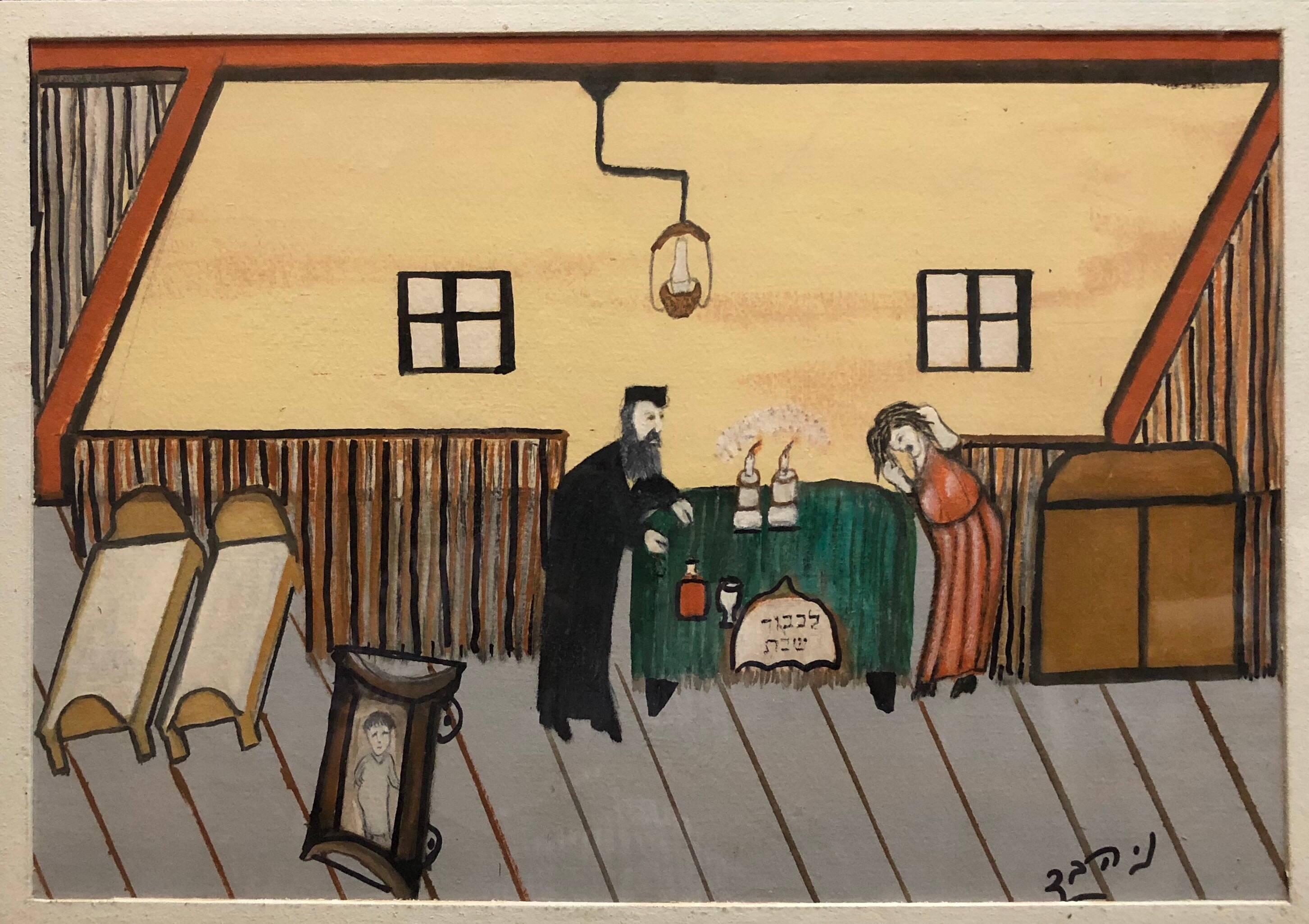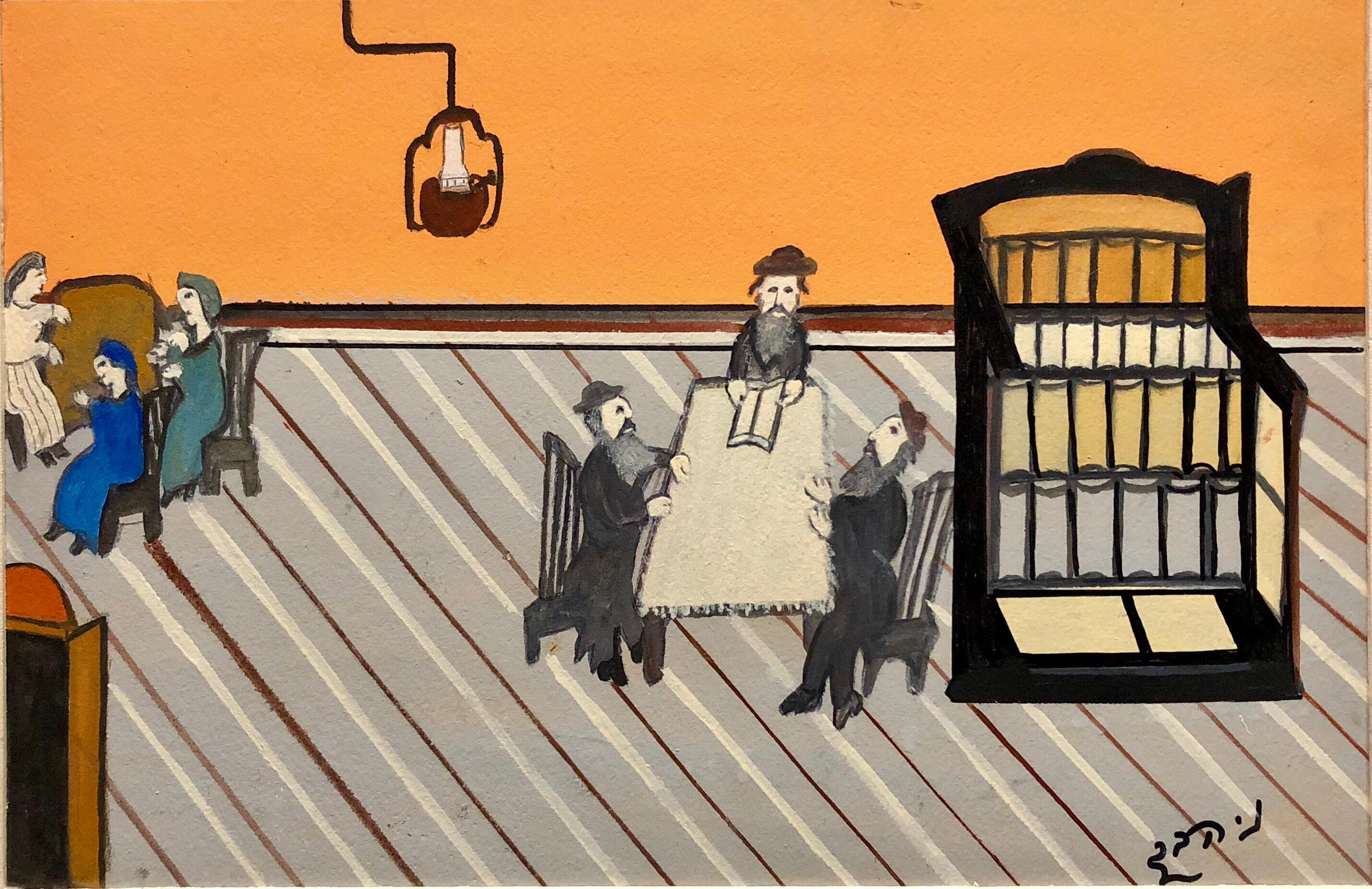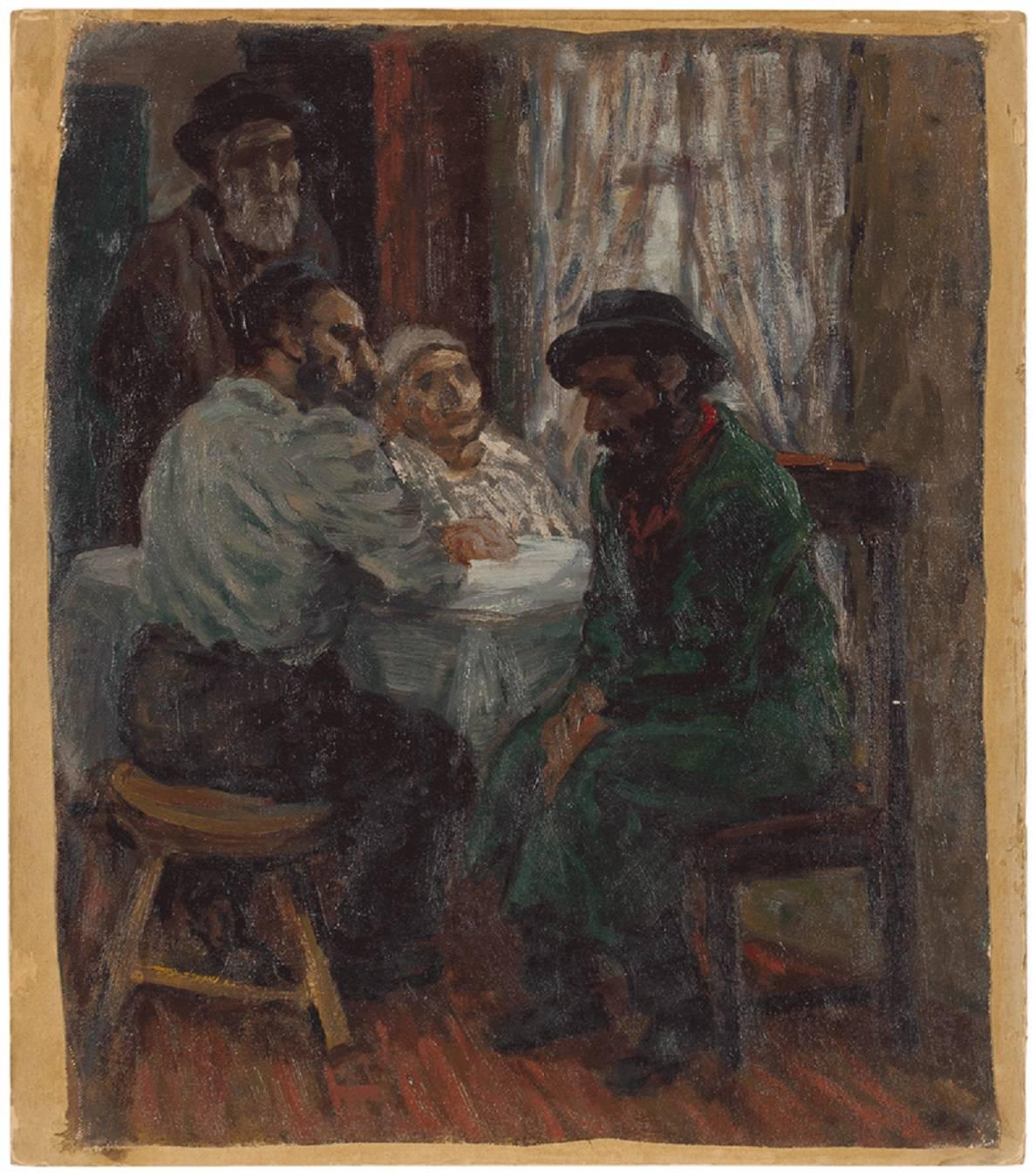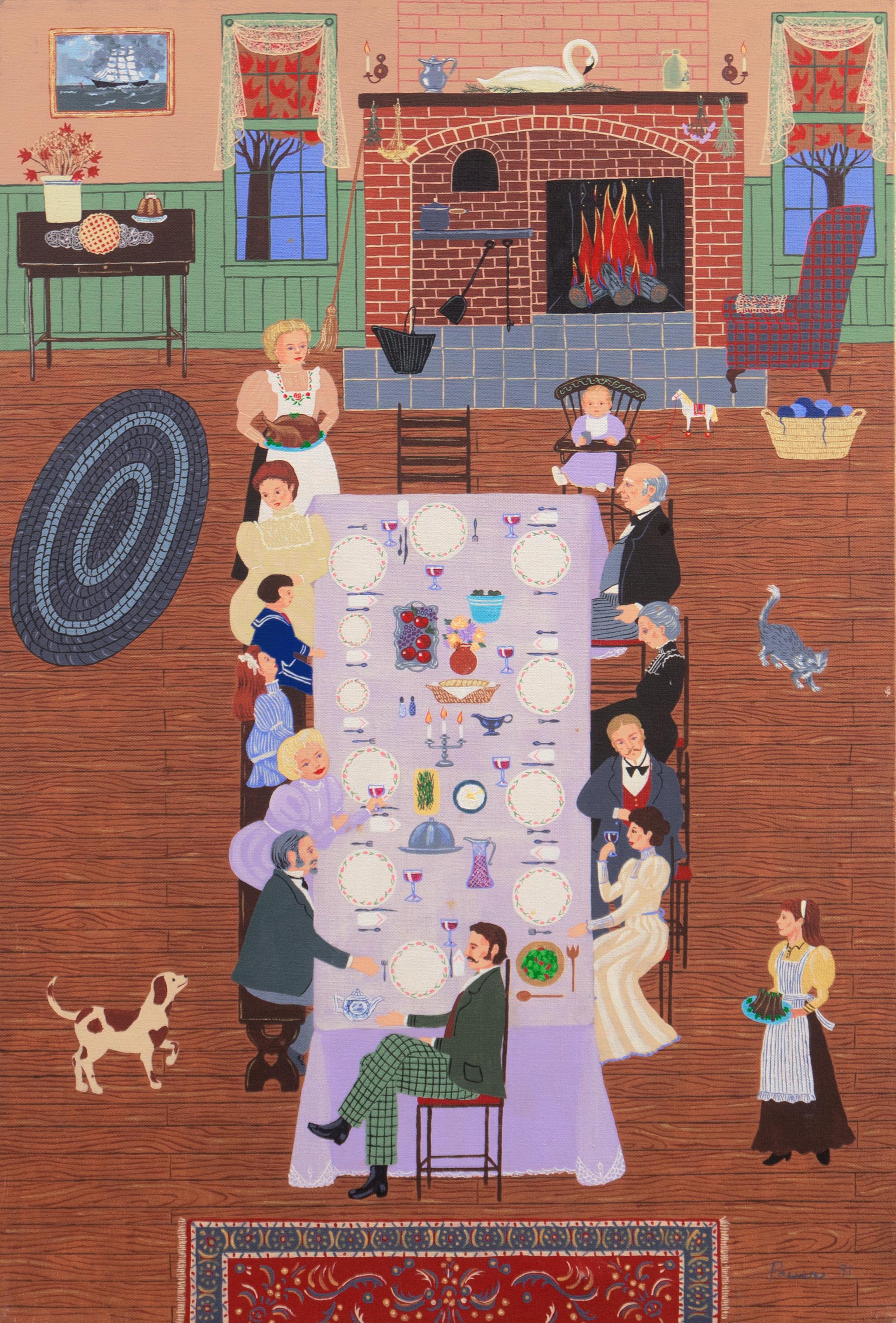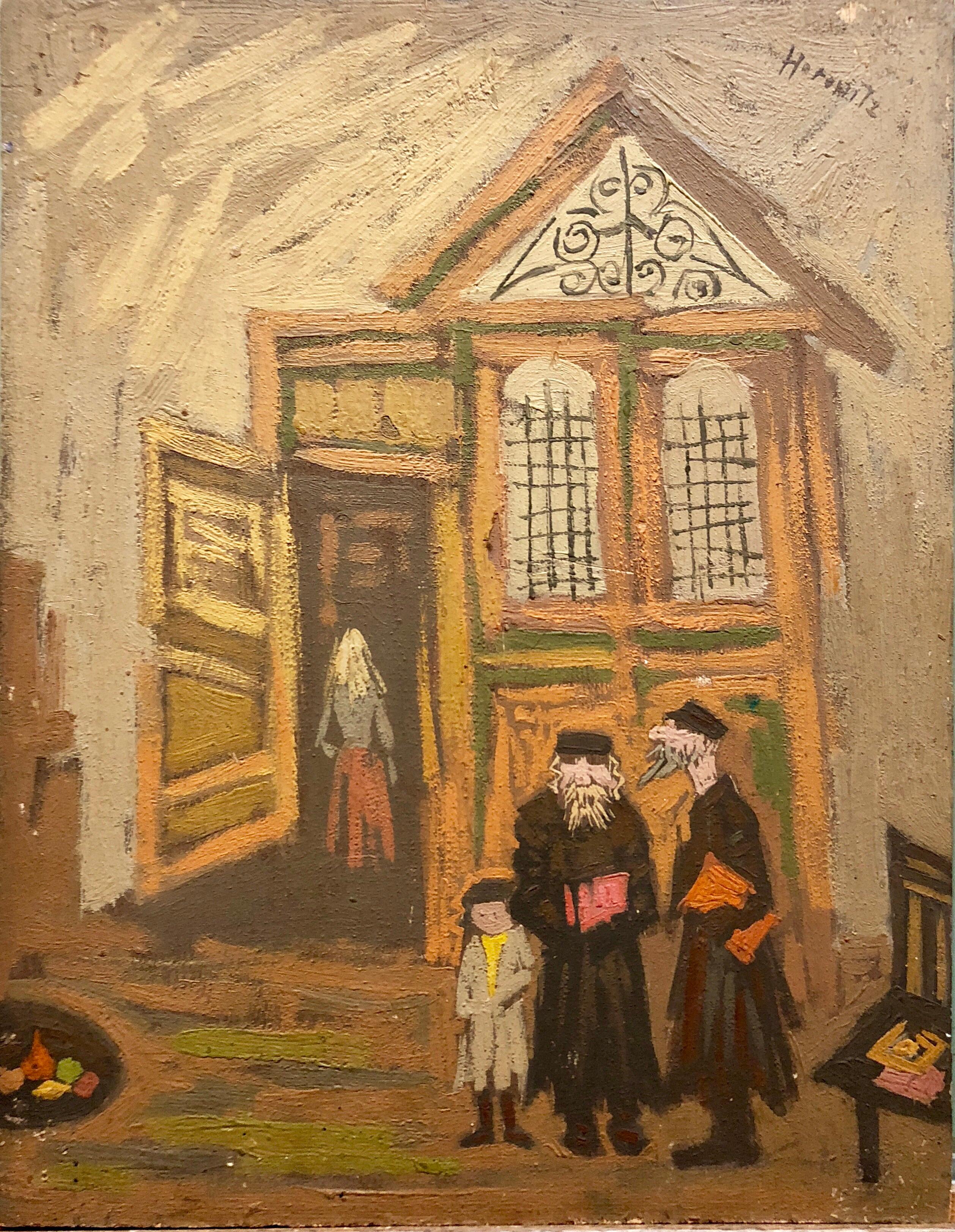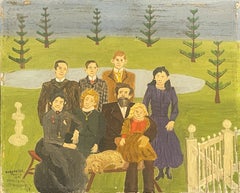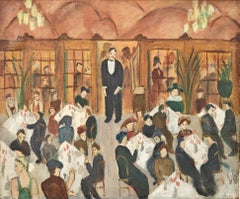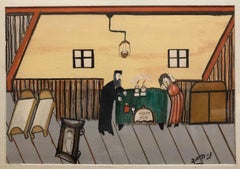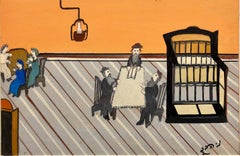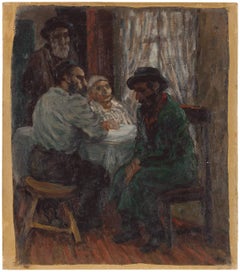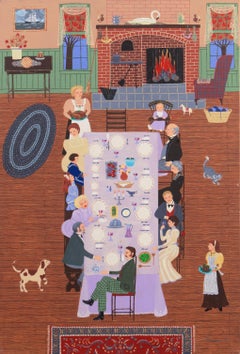Items Similar to "The Marriage Proposal (Family Gathering), " Leo Schutzman, Jewish Folk Art
Want more images or videos?
Request additional images or videos from the seller
1 of 9
Leo Schutzman"The Marriage Proposal (Family Gathering), " Leo Schutzman, Jewish Folk Artcirca 1958
circa 1958
$7,500
£5,643.05
€6,519.51
CA$10,599.46
A$11,508.95
CHF 6,094.83
MX$141,066.77
NOK 75,425.94
SEK 71,273.52
DKK 48,658.97
About the Item
Leo Schutzman (1878 - 1962)
The Marriage Proposal, circa 1958
Oil on canvas
24 x 20 inches
Signed lower left
Leo (Kyle) Schutzman (1878-1962) developed a reputation in New York in the 1950s as the ‘Jewish Grandma Moses.’ The characterization was particularly appropriate. Both artists only took up painting in a serious way in their old age after retiring from work. They also shared a popular aesthetic style then known as ‘primitivism’ or ‘naive art,’ far from the abstract expressionism that was the art critic’s darling at the time.
Schutzman was born Leo Kyle in Russia around 1878. His father died when he was 3 years old and he immigrated to England in his teens, where he remained for 9 years. When he moved to the United States in 1905, he took the name Schutzman after a German family who was renting to his nephew, Louis Kyle.
In New York City, Schutzman worked in the Jewish-dominated clothing industry, producing underwear as well as lace and embroidery. He founded the Victory Undergarment Company and the business was successful enough to provide for his family until he retired at about age 74.
After retirement, Schutzman took art courses at the Brooklyn Museum and began painting. He often depicted scenes of Jewish religious life that he remembered from childhood in Russia. His work seemed the very definition of ‘naive art’ as it was personified by Grandma Moses in the 1950s. His clumsy human figures sometimes had no features at all, or were portrayed with just a slash for the mouth and two dots for the eyes. He had only the vaguest sense of perspective and often used dissonant colors in unusual places.
Schutzman had his first one-man show in 1958, when he was 80 years old, at The Contemporaries gallery (992 Madison Ave.). His optimistic primitivism was popular in the United States in the 1950s as was his backstory; an immigrant who had succeeded as an entrepreneur in the capitalist system before affirming the democratic individualist creed that everyone had talents and could accomplish something at any age. He was soon socializing at parties with people like heiress/artist Gloria Vanderbilt. One of his ‘non-Jewish’ works depicting a winter carnival was chosen in 1962 for the United Nations Children’s Fund Christmas Card Collection.
When Grandma Moses died in 1961, naive art began to lose popularity Schutzman was living in Glendale Queens when he died at age 83 in 1962 and his reputation soon disappeared. In 1986, two of his paintings were acquired by the Jewish Museum in New York City. One of them, “The Wedding,” (c. 1960) was an iconic portrait of an Ashkenazic wedding. It has been reproduced by the Jewish Museum on popular stationery, and has appeared in popular books such as The Complete Idiot's Guide to Understanding Judaism.
Schutzman had three children, one of whom, Steven Kyle (1913-1979; nee Siegfried Schutzman)), married Betty Comden (1917-2006) in 1942. Comden, along with her writing partner Adolph Green, was the award-winning lyricist of many memorable Broadway and film musicals of the mid-1900s including “Singin’ in the Rain,” “On the Town,” “Peter Pan,” and “The Bandwagon.”
Leo Schutzman never minded the comparisons to Grandma Moses. He actually visited her in 1953 to show her some of his works and receive some advice from the 93-year-old painter. Both artists were noted for expunging the grim realities of life, choosing instead to focus on simple and generally joyful scenes. Schutzman once summed up his philosophy: “It doesn’t make any difference to me what they call my style as long as people enjoy the paintings.”
- Creator:Leo Schutzman (1878 - 1962, American, Russian)
- Creation Year:circa 1958
- Dimensions:Height: 27 in (68.58 cm)Width: 23 in (58.42 cm)
- Medium:
- Movement & Style:
- Period:
- Condition:
- Gallery Location:New York, NY
- Reference Number:1stDibs: LU184129905782
Leo Schutzman
Leo (Kyle) Schutzman (1878?-1962) developed a reputation in New York in
the 1950s as the ‘Jewish Grandma Moses.’ The characterization was particularly
appropriate. Both artists only took up painting in a serious way in their old age
after retiring from work. They also shared a popular aesthetic style then known as
‘primitivism’ or ‘naive art,’ far from the abstract expressionism that was the art
critic’s darling at the time. Schutzman was born Leo Kyle in Russia around 1878. His father died when
he was 3 years old and he immigrated to England in his teens, where he remained
for 9 years. When he moved to the United States in 1905, he took the name
Schutzman after a German family who was renting to his nephew, Louis Kyle.
In New York City, Schutzman worked in the Jewish-dominated clothing
industry, producing underwear as well as lace and embroidery. He founded the
Victory Undergarment Company and the business was successful enough to
provide for his family until he retired at about age 74. After retirement, Schutzman took art courses at the Brooklyn Museum and
began painting. He often depicted scenes of Jewish religious life that he
remembered from childhood in Russia. His work seemed the very definition of
‘naive art’ as it was personified by Grandma Moses in the 1950s. His clumsy
human figures sometimes had no features at all, or were portrayed with just a slash
for the mouth and two dots for the eyes. He had only the vaguest sense of
perspective and often used dissonant colors in unusual places. Schutzman had his first one-man show in 1958, when he was 80 years old, at
The Contemporaries gallery (992 Madison Ave.). His optimistic primitivism was
popular in the United States in the 1950s as was his backstory; an immigrant who
had succeeded as an entrepreneur in the capitalist system before affirming the
democratic individualist creed that everyone had talents and could accomplish
something at any age. He was soon socializing at parties with people like
heiress/artist Gloria Vanderbilt. One of his ‘non-Jewish’ works depicting a winter
carnival was chosen in 1962 for the United Nations Children’s Fund Christmas
Card Collection. When Grandma Moses died in 1961, naive art began to lose popularity
Schutzman was living in Glendale Queens when he died at age 83 in 1962 and his
reputation soon disappeared. In 1986, two of his paintings were acquired by the
Jewish Museum in New York City. One of them, “The Wedding,” (c. 1960) was an
iconic portrait of an Ashkenazic wedding. It has been reproduced by the Jewish
Museum on popular stationery, and has appeared in popular books such as The
Complete Idiot's Guide to Understanding Judaism.
About the Seller
5.0
Platinum Seller
Premium sellers with a 4.7+ rating and 24-hour response times
Established in 2022
1stDibs seller since 2022
122 sales on 1stDibs
Typical response time: <1 hour
- ShippingRetrieving quote...Shipping from: Saratoga Springs, NY
- Return Policy
Authenticity Guarantee
In the unlikely event there’s an issue with an item’s authenticity, contact us within 1 year for a full refund. DetailsMoney-Back Guarantee
If your item is not as described, is damaged in transit, or does not arrive, contact us within 7 days for a full refund. Details24-Hour Cancellation
You have a 24-hour grace period in which to reconsider your purchase, with no questions asked.Vetted Professional Sellers
Our world-class sellers must adhere to strict standards for service and quality, maintaining the integrity of our listings.Price-Match Guarantee
If you find that a seller listed the same item for a lower price elsewhere, we’ll match it.Trusted Global Delivery
Our best-in-class carrier network provides specialized shipping options worldwide, including custom delivery.More From This Seller
View All"Simchat Torah in the Synagogue, " Leo Schutzman, Jewish Folk Art
By Leo Schutzman
Located in New York, NY
Leo Schutzman (1878 - 1962)
Simchat Torah in the Synagogue, circa 1958
Oil on canvas
40 x 36 inches
Signed lower left
Provenance:
The Contemporaries Gal...
Category
1950s Folk Art Figurative Paintings
Materials
Canvas, Oil
"Overholser Family, 1890, Sterling, Illinois" Streeter Blair, 1949 Painting
Located in New York, NY
Streeter Blair
Overholser Family, 1890, Sterling, Illinois, 1949
Signed, titled, and dated lower left
Oil on canvas
8 x 10 inches
Primitive painter St...
Category
1940s Outsider Art Figurative Paintings
Materials
Canvas, Oil
"Restaurant" Adelaide Lawson Gaylor, American Modernist Interior Party Scene
Located in New York, NY
Adelaide Lawson Gaylor
Restaurant
Signed lower right
Oil on canvas
24 1/4 x 30 inches
Modernist artist Adelaide Jaffrey Lawson Gaylor was born in New York City and learned at the A...
Category
1950s Modern Figurative Paintings
Materials
Canvas, Oil
"The Gathering" Theresa Bernstein, Abstracted Figures Ashcan School Artist
By Theresa Bernstein
Located in New York, NY
Theresa Bernstein
The Gathering, circa 1990
Signed lower right
Mixed media on paper
9 x 10 3/4 inches
Theresa F. Bernstein was born in Philadelphia in 1895 to cultured, middle-clas...
Category
1990s Abstract Abstract Drawings and Watercolors
Materials
Paper, Mixed Media
"Kuhn Family Holiday Card" Walt Kuhn, Greeting Card by American Modernist
By Walt Kuhn
Located in New York, NY
Walt Kuhn
Kuhn Family Holiday Card
Lithograph on paper
6 1/4 x 3 3/4 inches
Walter Kuhn was born on October 27, 1877 in Brooklyn, NY. His father, Francis Kuhn, was the owner of a s...
Category
1930s Modern Figurative Prints
Materials
Lithograph
"The Beginning" Aaron Bohrod, Pun Humor, Magic Realism, Alphabet Letters, Text
By Aaron Bohrod
Located in New York, NY
Aaron Bohrod
The Beginning, 1990
Signed center
Oil on gesso board
10 x 8 inches
Aaron Bohrod's work has not been limited to one style or medium. Initially recognized as a regionalis...
Category
1990s Realist Animal Paintings
Materials
Oil, Board
You May Also Like
Israeli Judaica Shtetl Family Shabbat Scene Naive Art Oil Painting
By Natan Heber
Located in Surfside, FL
Natan Heber was trained by his father in Poland to be a ritual slaughterer. In 1925, he joined the Zionist movement "Mizrachi" and in 1936 immigrated to Palestine where he opened a poultry shop in Haifa. He began to paint at the age of sixty-one, after ill health forced him to retire. Driven by a need to memorialize his family and their shtetl community lost in the Holocaust, he drew scenes of traditional Jewish life. Unfamiliar with the conventions of scale and perspective, he set his heavily outlined frontal figures on steeply rising surfaces and often portrayed his father in monumental size to mark his importance. One of Israel's greatest naive-style painters. Along with Shalom of Safed, Kopel Gurwin and Gabriel Cohen, He is renowned as one of Israel's greatest living naive-style folk art painters, The Haifa Museum of Art will be opening the first ever Outsider Art exhibition (also known as Art Brut) in Israel in January 2013.
He was included in the show of Outsider art at Haifa Museum The exhibition included works by Classical Outsider artists, none of them have ever been shown in Israel - Henry Darger, Martin Ramirez, Adolf Wölfli, Aloïse, Hauser, Carlo Zinnelli, Bill Traylor, Minnie Evans...
Category
Mid-20th Century Folk Art Animal Paintings
Materials
Oil, Board
Israeli Judaica Shtetl "The Lesson" Rabbi Studying Scene Naive Art Oil Painting
By Natan Heber
Located in Surfside, FL
Natan Heber was trained by his father in Poland to be a ritual slaughterer. In 1925, he joined the Zionist movement "Mizrachi" and in 1936 immigrated to Palestine where he opened a poultry shop in Haifa. He began to paint at the age of sixty-one, after ill health forced him to retire. Driven by a need to memorialize his family and their shtetl community lost in the Holocaust, he drew scenes of traditional Jewish life. Unfamiliar with the conventions of scale and perspective, he set his heavily outlined frontal figures on steeply rising surfaces and often portrayed his father in monumental size to mark his importance. One of Israel's greatest naive-style painters. Along with Shalom of Safed, Kopel Gurwin and Gabriel Cohen, He is renowned as one of Israel's greatest living naive-style folk art painters, The Haifa Museum of Art will be opening the first ever Outsider Art exhibition (also known as Art Brut) in Israel in January 2013.
He was included in the show of Outsider art at Haifa Museum The exhibition included works by Classical Outsider artists, none of them have ever been shown in Israel - Henry Darger, Martin Ramirez, Adolf Wölfli, Aloïse, Hauser, Carlo Zinnelli, Bill Traylor, Minnie Evans, William Hawkins and Sam...
Category
Mid-20th Century Folk Art Animal Paintings
Materials
Oil, Board
Jewish Family Interior Scene (The Shadchan) Rare Judaica Oil Painting
By Albert Abramovitz
Located in Surfside, FL
The Matchmaker (The Shadchan) A rare Judaic Wedding Marriage Broker Scene.
Albert Abramovitz (1879-1963), born in Riga, Latvia, on January 24, 1879. He studied art at the Imperial ...
Category
Early 20th Century Figurative Paintings
Materials
Canvas, Oil, Board
'The Family Dinner', Thanksgiving, Christmas, Festive Reunion, Large Naive Oil
Located in Santa Cruz, CA
Signed lower right, 'Pauer' for Jacalyn Pauer (American, 20th century) and dated 1991. Additionally signed, verso, and titled, 'The Family Dinner'.
A substantial, American oil paint...
Category
1990s Folk Art Interior Paintings
Materials
Canvas, Acrylic
Judaica Oil Painting Jewish Family Interior Shtetl Scene
By Peter Horowitz
Located in Surfside, FL
Peter Horowitz, painter, born 1922, Poland. Lived in Hod Hasharon in Israel.
Studied at the Art Academy, Krakow. died in 2005.
Studies: Art Academy, Cracow. Peter Horowitz was born...
Category
Mid-20th Century Modern Figurative Paintings
Materials
Oil, Board
Dance of the In laws Wedding Scene Judaica Shtetl Oil Painting WPA Jewish Artist
By Maurice Kish
Located in Surfside, FL
Genre: Modern
Subject: Jewish Wedding Mechutanim
Medium: Oil
Surface: Board, size includes artist decorated frame
Country: United States
The imagery of Maurice Kish (1895-1987), whe...
Category
Mid-20th Century Modern Figurative Paintings
Materials
Oil
